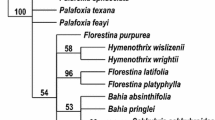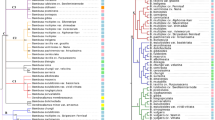Abstract
Phylogenetic relationships of ten wild species and several cultivars ofForsythia were reconstructed based on the chloroplast (cp) DNA variation. A total of 216 cpDNA variants, 44 of which were potentially phylogenetically informative, was detected using 24 restriction endonucleases. Phylogenetic analysis usingFontanesia andAbeliophyllum as outgroups revealed four well defined species groups in the genus: 1)F. suspensa, 2)F. europaea — F. giraldiana, 3)F. ovata — F. japonica — F. viridissima, and 4)F. koreana — F. manshurica — F. saxatilis. The amount of support for each monophyletic group was evaluated by various methods including character number, decay analysis, parsimony bootstrapping, Neighbour-Joining (NJ) — bootstrapping, NJ-jackknifing, and the topology-dependent permutation tail probability (T-PTP) test. The data do not support the hybrid origin ofF. intermedia fromF. suspensa andF. viridissima. The disjunctly distributed European species,F. europaea, was identified as a sister species of the ChineseF. giraldiana and it was probably derived through recent long distance dispersal.
Similar content being viewed by others
References
Anderson E. (1934) Hardy Forsythias. Arnoldia 2(3): 9–14.
Bass P., Esser P. M., van der Westen M. E. T., Zandee M. (1988) Wood anatomy of theOleaceae. Int. Assoc. Wood Anat. Bull. 9: 103–182.
Bremer K. (1988) The limits of amino acid sequence data in angiosperm phylogenetic reconstruction. Evolution 42: 795–803.
Bremer K. (1994) Branch support and tree stability. Cladistics 10: 295–304.
Chang M., Qui L., Green P. S. (1996)Oleaceae. In: We Z., Raven P. H. (eds.) Flora of China, 15. Science Press, Beijing; Missouri Botanical Garden Press, St. Louis, pp. 272–319.
Doyle J. J., Doyle J. L. (1987) A rapid DNA isolation procedure for small quantities of fresh leaf tissue. Phytochem. Bull. 19: 11–15.
Doyle J. J., Doyle J. L., Brown A. H. D. (1990) A chloroplast-DNA phylogeny of the wild perennial relatives of soybean (Glycine subgenusGlycine): congruence with morphological and crossing groups. Evolution 44: 371–389.
Faith D. P. (1991) Cladistics permutation tests for monophyly and nonmonophyly. Syst. Zool. 40: 366–375.
Faith D. P., Cranston P. (1991) Could a cladogram of this sort have arisen by chance alone? On permutation tests for cladistics structure. Cladistics 7: 1–28.
Felsenstein J. (1985) Confidence limits on phylogenies: an approach using the bootstrap. Evolution 39: 783–791.
Green P. S. (1972)Forsythia. In: Tutin T. G., Heywood V. H., Burges N. A., Moore D. M., Valentine D. H., Walters S. M., Webb D. A. (eds.) Flora Europaea 3. Cambridge University Press, Cambridge, p. 53.
Harborne J. B., Green P. S. (1980) A chemotaxonomic survey of flavonoids in leaves of theOleaceae. Bot. J. Linn. Soc. 81: 155–167.
Hillis D. M. (1991) Discriminating between phylogenetic singal and random noise in DNA sequences. In: Miyamoto B. K., Cracraft J. (eds.) Phylogenetic analysis of DNA sequence data. Oxford University Press, New York, pp. 278–294.
Hillis D. M., Dixon M. T. (1989) Vertebrate phylogeny: evidence from 28S ribosomal DNA sequences. In: Fernholm B., Bremer K., Jornvall H. (eds.) The hierarchy of life. Elsevier, Amsterdam, pp. 355–367.
Hillis D. M., Huelsenbeck J. P. (1992) Signal, noise, and reliability in molecular phylogenetic analyses. J. Heredity 83: 189–195.
Jansen R. K., Wee J. L., Millie D. (1998) Comparative utility of chloroplast DNA restriction site and DNA sequence data for phylogenetic studies in plants. In: Soltis D., Soltis P., Doyle J. (eds.) Molecular systematics of plants II-DNA sequencing. Kluwer Academic Pub., New York, pp. 87–100.
Johnson L. A. S. (1957) Review of the familyOleaceae. Contrib. New South Wales Natl. Herb. 2: 395–418.
Kim K.-J., Jansen R. K. (1994) Comparisons of phylogenetic hypotheses among different data sets in dwarf dandelions (Krigia, Asteraceae): additional information from internal transcribed spacer sequences of nuclear ribosomal DNA. Plant Syst. Evol. 190: 157–185.
Kim K.-J., Jansen R. K. (1998) A chloroplast DNA phylogeny of lilacs (Syringa-Oleaceae): plastome groups show a strong correlation with crossing groups. Amer. J. Bot. 82: 1338–1351.
Kim K.-J., Turner B. L., Jansen R. K. (1992) Phylogenetic and evolutionary implications of interspecific chloroplast DNA variation inKrigia (Asteraceae-Lactuceae). Syst. Bot. 17: 449–469.
Lee S. (1984) A systematic study of KoreanForsythia species. Korean J. Pl. Taxon. 19: 229–230.
Lee S., Park E. J. (1982) A palynotaxonomic study of the KoreanOleaceae. Korean J. Pl. Taxon. 12: 1–11.
Lee Y. L. (1996) Flora of Korea. Kyohaksa, Seoul.
Lim S. C., Ko S. C. (1989) A cytotaxonomical study on some species of KoreanForsythia. Korean J. Pl. Taxon. 19: 229–230.
Maddison D. R. (1991) The discovery and importance of multiple islands of most-parsimonious trees. Syst. Zool. 40: 315–328.
Melchior H. (1964) A. Engler's Syllabus der Pflanzenfamilien, 2. Borntraeger, Berlin.
Nakai T. (1919) Genus novum Oleacearum in Corea media inventum. Bot. Mag. (Tokyo) 33: 153–154.
Nei M. (1987) Molecular evolutionary genetics. Columbia University Press, New York.
Nei M., Li W.-H. (1979) Mathematical model for studying genetic variation in terms of restriction endonucleases. Proc. Natl. Acad. Sci. USA 76: 5269–5273.
Olmstead R. G., Palmer J. D. (1992) A chloroplast DNA phylogeny of theSolanaceae: subfamilial relationships and character evolution. Ann. Missouri Bot. Gard. 79: 346–360.
Olmstead R. G., Palmer J. D. (1994) Chloroplast DNA systematics: a review of methods and data analysis. Amer. J. Bot. 81: 1205–1224.
Palmer J. D. 1986: Isolation and structural analysis of chloroplast DNA. Meth. Enzymol. 118: 167–186.
Palmer J. D., Jansen R. K., Michaels H. J., Chase M. W., Manhart J. W. (1988) Chloroplast DNA variation and plant phylogeny. Ann. Missouri Bot. Gard. 75: 1180–1206.
Palmer J. D., Downie S. R., Nugent J. M., Brandt P., Unseld M., Klein M., Brennicke A., Schuster W., Broner T. (1994) The chloroplast and mitochondrial DNAs ofArabidopsis thaliana: conventional genomes in an unconventional plant. In: Sommerville C., Meyerowitz E. M. (eds.)Arabidopsis. Cold Spring Harbor Press, New York, pp. 37–62.
Richards A. J. (1997) Plant breeding systems, 2nd edn. Chapman & Hall, London.
Sanderson M. J. (1989) Confidence limits on phylogenies: the bootstrap revisited. Cladistics 5: 113–129.
Sax K. (1947) Plant breeding at the Arnold Arboretum. Arnoldia 7(3): 9–12.
Soltis D. E., Kuzoff R. K. (1995) Discordance between nuclear and chloroplast phylogenies in theHeuchera group (Saxifragaceae). Evolution 49: 727–742.
Swofford D. L. (1998) PAUP: phylogenetic analysis using parsimony, version 4.0*. Sinauer, Sunderland, Massachusetts.
Taylor H. (1945) Cyto-taxonomy and phylogeny ofOleaceae. Brittonia 5: 337–369.
Wallace R. S., Jansen R. K. (1990) Systematic and evolutionary implications of chloroplast DNA variation in the genusMicroseris D. Don (Asteraceae:Lactuceae). Syst. Bot. 15: 606–616.
Wendel J. F. (1989) New world tetraploid cottons contains Old World cytoplasm. Proc. Natl. Acad. Sci. USA 86: 4132–4136.
Wendel J. F., Albert V. A. (1992) Phylogenetics of the cotton genus (Gossypium): character-state weighted parsimony analysis of chloroplast-DNA restriction site data and its systematic and biogeographic implications. Syst. Bot. 17: 115–143.
Wyman D. (1959) These are the Forsythias. Arnoldia 19(3): 11–14.
Wyman D. (1961) Registration lists of cultivar names of Forsythias. Arnoldia 21: 39–42.
Yamazaki T. (1993)Oleaceae. In: Iwatsuki K., Yamazaki T., Boufford D. E., Ohba, H. (eds.) Flora of Japan, 3. Kodansa, Tokyo, pp. 122–135.
Author information
Authors and Affiliations
Rights and permissions
About this article
Cite this article
Kim, KJ. Molecular phylogeny ofForsythia (Oleaceae) based on chloroplast DNA variation. Pl Syst Evol 218, 113–123 (1999). https://doi.org/10.1007/BF01087039
Received:
Accepted:
Issue Date:
DOI: https://doi.org/10.1007/BF01087039




